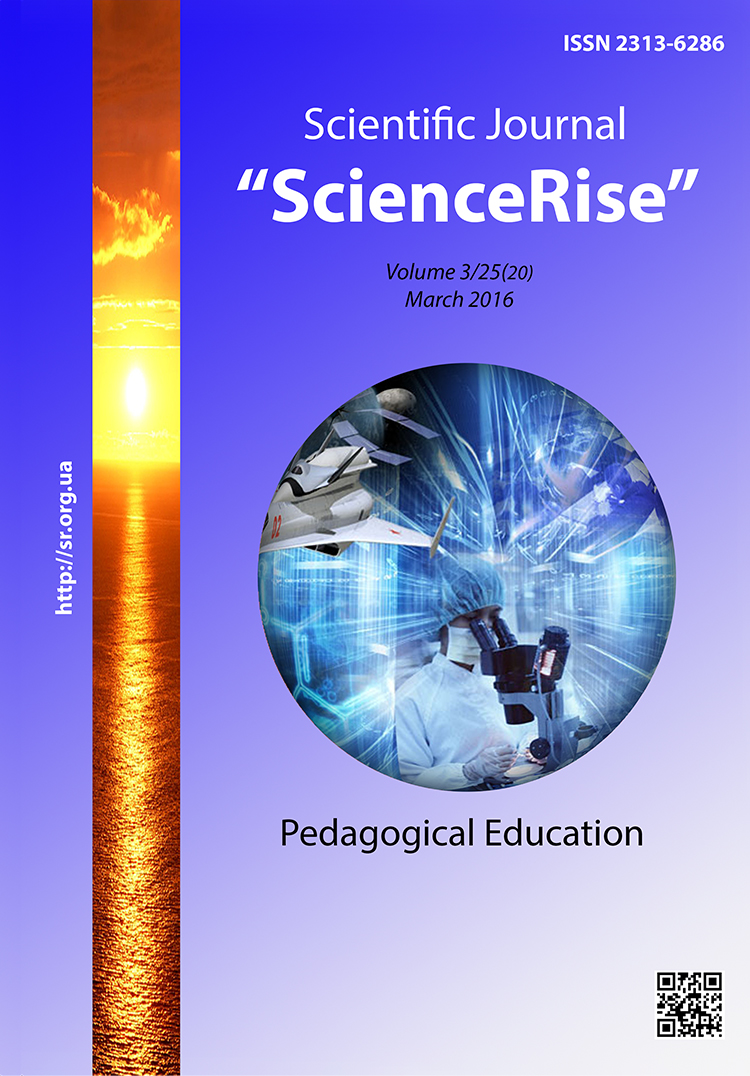Artictis and creative development of junior schoolchildren during the labor education
DOI:
https://doi.org/10.15587/2313-8416.2016.63862Keywords:
creation, artistic and creative development, junior school age, decorative and applied artsAbstract
The article deals with a topical problem of artistic and creative development of junior schoolchildren during labor process. There were considered the diverse aspects of problem of personal creative activity. The special attention was paid to importance of combining labor, creation and artistic activity in educational process. On the base of experimental research there was considered the modern state of artistic and creative development of pupils in elementary school. By analysis of the theory and practice of artistic and creative development of junior schoolchildren during labor education there was determined inexpediency of excessive reproductive approach to the labor activity of children that impedes emotional, spiritual and esthetic development transforming the work of children into the boring and ineffective one. There was determined the criteria of artistic and creative development of junior schoolchildren during the labor education. During the study there were defined principles that reveal content, essence and nature of creation. There were defined peculiarities of artistic and creative development of junior schoolchildren at the lessons of labor education and distinguished the main sings that characterize mechanism of creative activity of junior schoolchildren. There was grounded pedagogical expediency of artistic and creative approach to the work with junior schoolchildren
References
Klepikov, O. I. (1991). Tvorchist: istyna, krasa, blaho [Creativity: truth, beauty, good]. Kyiv: Znannya, 48.
Kucheryavyi, I. T., Klepikov, O. I. (2000). Tvorchist – osnova rozvytku potentsiynykh dzherel osobystosti [Creativity – the basis of potential sources of identity]. Kyiv: Vyshcha shkola, 288.
Romenets, V. A. (2001). Psykholohiya tvorchosti [Creativity psychology]. Kyiv: Lybid, 286.
Parnuk, M. A. (1967). Determinizm dialekticheskogo materializma [Determinism of dialectical materialism]. Kyiv: Naukova dumka, 260.
Suhomlinskiy, V. A. (1979). Izbrannye proizvedeniya [Selected works]. Vol. 4. Kyiv: Rad. shkola, 669.
Kan-Kalik, V. A., Nikadirov, N. D. (1990). Pedagogicheskoe tvorchestvo [Teacher creativity]. Moscow: Pedagogika, 144.
Lozova, V. I. (2001). Tsilisnyy pidkhid do formuvannya piznavalnoyi aktyvnosti shkolyariv [A holistic approach to the formation of the cognitive activity of students]. Kharkiv: OBS, 164.
Melyk-Pashaev, A. A. (1998). Ob istochnike sposobnosti cheloveka k khudozhestvennomu tvorchestvu [On the source of the human capacity for artistic creativity]. Voprosy psikholohiyi, 1, 76–78.
Molyako, V. A. (1994). Problemy psikholohiyi tvorchestva i razrabotka podkhoda k izucheniyu odaronnosti [Problems of psychology of creativity and the development of an approach to the study of giftedness]. Voprosy psikholohiyi, 5, 86–95.
Voronuk, I. (2003). Psyhologichni osoblyvosti realizatsii tvorchogo potentsialu molodshyh shkolariv [Psychological characteristics realize the creative potential of younger students]. Kyiv, 23.
Masol, L. M. (2006). Metodyka navchannya mystetstva u pochatkoviy shkoli [Methods of teaching art at primary school]. Kharkiv: Ranok, 130.
Savenkov, A. I. (1999). Detskaya odaronnost: razvitie sredstvami iskusstva [Children's genius: the development of means of art]. Moscow: Pedagogicheskoe obshhestvo Rossii, 220.
Tymenko, V. P. (1997). Programa integrovanogo kursu “Hudozna pratsa” (1–4 kl.) [The program is integrated course "Artistic work" (1–4 cl.)]. Pochatkova shkola, 8, 45–51.
Vitkovskaya, N. S., Scherbo, A. B., Dzola, D. N. (1985). Formirovanie esteticheskoy kultury mladshyh shkolnikov: iz opyta raboty [Formation of aesthetic culture of younger schoolboys: from experience]. Kyiv: Radanska shkola, 134.
Demchenko, I. (2002). Tvorchyy rozvytok molodshykh shkolyariv zasobamy obrazotvorchoho mystetstva [Creative development of younger schoolboys means of the fine arts]. Ridna shkola, 6, 62–64.
Savchenko, O. Y. (1999). Dydaktyka pochatkovoyi shkoly [Didactic Primary School]. Kyiv: Geneza, 368.
Tarasenko, G. S. (2003). Parostok. Metodyka humanistychnogo vykhovannya molodshykh shkolyariv zasobamy pryrody [Sprout. Methodology of Art Education primary school children]. Ternopil: Navchal'na kniga – Bogdan, 144.
Scherbo, A. B. (1983). Formirovanie u mladshyh shkolnikov sposobnostey k hudozestvenno-esteticheskoy deyatelnosti [Formation at younger schoolboys of abilities to is art-aesthetic activity]. Kyiv, 48.
Kucheruk, D. (1989). Estetika truda: tsennostnye otnosheniya, tvorchestvo, chelovek [Labour Aesthetics: valuable relationships, creativity, man]. Kyiv: Vyshcha shkola, 152.
Lihachov, B. T. (1985). Teoriya esteticheskogo vospitaniya shkolnikov [The theory of aesthetic education]. Moscow: Prosveschenie, 176.
Tsapok, V. A. (1989). Tvorchestvo (Filosofskiy aspect problemy) [Creation (The philosophical aspect of the problem)]. Kishinev, 98.
Vygotskiy, L. S. (1991). Tvorchesyvo I voobrazenie v detskom vozraste [Creativity and imagination in childhood]. Moscow: Prosveschenie, 93.
Salchenok, N. V. (1999). Psikhologiya khudozhestvennogo tvorchestva [Psychology of art]. Minsk: Kharvest, 752.
Yakobson, P. M. (1964). Psihologia hudozestvennogo vospriyatia [Psychology of artistic perception]. Moscow: Prosveschenie, 85.
Levchenko, G. E., Voloshhuk, І. S., Zagajkevich, L. V. (1990). Osnovy dyzaynu: navchalna programa [Design Basics]. Kyiv: UNDIP, 12.
Madzigon, V. M. (2005). Vymogy naukovo-tehnichnogo progresu do zmistu i harakteru trudovoi politehnichnoi pidgotovky uchiv [Requirements of scientific and technological progress to the content and nature of the job training]. Molod i rynok, 3 (13), 5–9.
Thorzevskyy, D. O. (1972). Dydaktyka trudovogo navchanna [Didactics labor training]. Kyiv: Radanska shkola, 224.
Starovoit, L. V. (2015). Khudozhnye konstruyuvannya z paperu ta kartonu [The artistic design of paper and paperboard]. Vinnytsya: FOP Korzyn D. Ju., 168.
Downloads
Published
Issue
Section
License
Copyright (c) 2016 Леся Василівна Старовойт

This work is licensed under a Creative Commons Attribution 4.0 International License.
Our journal abides by the Creative Commons CC BY copyright rights and permissions for open access journals.
Authors, who are published in this journal, agree to the following conditions:
1. The authors reserve the right to authorship of the work and pass the first publication right of this work to the journal under the terms of a Creative Commons CC BY, which allows others to freely distribute the published research with the obligatory reference to the authors of the original work and the first publication of the work in this journal.
2. The authors have the right to conclude separate supplement agreements that relate to non-exclusive work distribution in the form in which it has been published by the journal (for example, to upload the work to the online storage of the journal or publish it as part of a monograph), provided that the reference to the first publication of the work in this journal is included.

